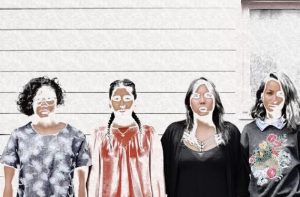(Akiit.com) This design, originally proposed by Bard College student Coriana Johnson, depicts colorblindness as a form of whitewashing. In rejecting the connection between race, culture, and identity, the default color becomes white.
Many of us, as young adolescents, have been given tremendous context as to what is considered beautiful and worthy in terms of skin color. Some of us have even been referred to skin lightening creams to resemble a lighter image of ourselves. We have been taught that “color” matters, with acceptance and beauty weighted in favor of lightness. There is no truer portrait of the self-hatred permeating among people of color than the one extolled by such an ideology. And even when we are described as beautiful, we remain perplexed and sadly reject this view because of the se duction of colorism. It shows that, although we acknowledge that our skin tones do not reflect the strengths and authenticity we hold deep inside, this kind of evil runs deeper than the melanin that resonates with the pain of living in a bubble of white privilege; one that proves deadly to our identities.
duction of colorism. It shows that, although we acknowledge that our skin tones do not reflect the strengths and authenticity we hold deep inside, this kind of evil runs deeper than the melanin that resonates with the pain of living in a bubble of white privilege; one that proves deadly to our identities.
We have people who prefer to “wash away” their color, if they can. We have people who are simply ashamed because they are a darker shade than their friend of the same race/ethnicity. To say the least, our image of color has sadly become perverted and racialized. External beauty now requires more validation than ever, and that is the reason for why skin tone inequality operates so successfully. This devaluation of the deeper business of feeling beautiful and worthy has also come to surface in public dialogue about the new form of racism: colorblindness.
What exactly is colorblindness?
Colorblindness professes a new wave of thinking to end discrimination by treating everyone as equally as possible; disregarding race, culture, and ethnicity. Such notion entails a lack of acknowledgment of the very real ways in which racism has persisted and continues to do so, both systematically and on an individual level.
Nestled in a intellectualized, white-washed bubble, race is underestimated for its underlying destructive connotations that ultimately robs people of their freedom to embrace their identities as a whole. There is no precedent for such a trajectory that encourages people to adopt a dangerous approach that attests to the fact that “we’re all just people”. This new wave of thinking avoids conversations on race. It’s a total no-no. It invalidates the racial issues that marred us as a society. Colorblindness naively suggests that the depths of racism experienced in our past are of a bygone society although they very much affect individuals till this day. Yet, many are “blind” to the ways society caters to colorism and racial disparities.
But isn’t colorblindness trying to see people for who they are despite their race?
No. We live in a society that superficially obscures colorism with colorblindness in a counterproductive way in which color becomes the problem. It falsely equates color with something uncomfortable and negative. Denying people their identities only harkens back to how internally segregated they already felt in the past when they were reminded of how dark and different they were. Not only that, colorblindness is a toxic force vulnerable to ignoring the determining factor – race – in linguistic racism, health disparities in racial minority communities, and microaggressions alike. How do you plan to eradicate these issues without talking about the pertinence of racial categories? If race truly does not matter, such disparities embedded in language, health, and behavior, simply would not exist.
So how DO we promise equality for all then?
First, and foremost, we need to stop pretending race is off the table. It’s not. Race is inherently tied to culture, language, and tradition. It is a central part of people’s’ identities that is very real and entangled with judgement, success, and quality of life. Instead, we need to utilize the oppression, subjection to violence and internalization, and turn these things into conversation pieces to allow us to work through our opposing views. We need to stop resisting the resistance on how our melanin is racialized and, inevitably, white-washed through colorism and racism. Stories need to be heard and given their deserved attention if we want true progress. Who benefits from ignoring such conversations? Not the ones who already feel subordinated by their skin color. If we can’t have a healthy and honest dialogue, how can we ever move towards ending racial oppression?
Doing a person of color a favor by treating them like a white person (or, in other words, like a human being) does not do justice to the equality movement. Having savaged that straw man, those who adhere to this form of colorblindness contribute to the perpetuation of oppression. If we want a shift of perspective – a shift of morals – it is crucial that we become conscious of the privileges and prejudices that come as a result of our colors. THIS is how we prompt action towards letting go of racist fears that still bind us to the prejudices we’ve internalized.
To see reality more fully, we need to be color- conscious, not color-blind.
Columnist; Sabrina Sultana
Official website; http://www.huffingtonpost.com/sabrina-sultana/









Leave a Reply